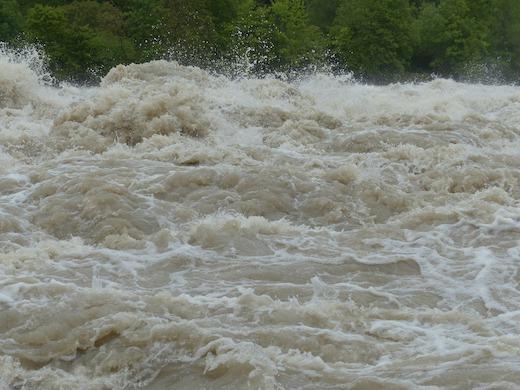Log homes are actually more durable than traditional homes and are more likely to survive natural disasters, including flooding. The clean-up and repair of a log home after flooding is also much easier if you follow these steps provided by Perma-Chink.

INTERIOR 1) Tear out everything that is obviously ruined or that will interfere with drying out the log walls. All floor coverings (you will not be able to save any wooden floor – even if it looks good now, it will warp), trim, drywall, and insulation must go. You will probably have to replace all wet cabinetry and interior doors that were stained or contained any type of composite wood. Sometimes cabinets and doors can be saved if they were initially painted or if you choose to paint them now. Cut drywall and insulation about a foot above the high water mark. Sometimes tile floors can be saved, depending on the backer used under the tile.
2) Clean – Water usually brings in a great deal of mud or other contaminates. Once areas are cleared of debris and other building components mentioned above, then pressure-wash the log walls, studs, other framing, and sub-floors. Use products like Log Wash or Wood Renew to help lift out dirt and begin to control mold and mildew. Try not to use bleach as it can change the color of wood which can cause problems later. If you MUST use bleach, use no more than a cup per gallon of water and try to keep it off of wood that did not get wet. Apply the cleaners from bottom to top and then wash the dirt down the walls, across the floor, and out the door.
3) Dry out the log and timber components left behind. De-humidifiers are best at this task along with fans. If electricity is not available, just do your best to provide some air circulation. If only one de-humidifier is available, use it in one room at a time – running constantly until the moisture content of the wood in the wettest area of the room is below at LEAST 17%. Moisture meters are available at home centers and hardware stores. If your home is on a crawl space, close all the vents, install a new vapor barrier, and install a couple of de-humidifiers. This will quickly dry the space under the home and the sub-floor. If electricity is not available, consider removing sections of the sub-floor to provide some air circulation.
4) Disinfect – As soon as the wood is dry to the touch after cleaning. Liberally spray a mold control product on everything that got wet – Concorbium is one brand name. These products are commonly available at stores like Lowe’s or Home Depot. Buy a lot and use it. I have found these products work wonders stopping mold, mildew, and the odors and stains that accompany them. You may have to re-apply if it takes a while to dry your home out due to lack of electricity or equipment.
5) Replace and Re-build – I recommend replacing all electrical outlets and switches that were under water. If in doubt about electrical components, ask an electrician. I did not replace mine initially and had trouble later. Replace all drywall, insulation trim and re-finish. If you have a lot of open interior stud walls, I recommend applying powdered borax like Armor Guard inside the stud cavities and THEN closing them up. The borate will stay there practically forever and kill ants and roaches that crawl through it and then consume it as they groom themselves. Also apply this powder on the floor just before you re-install base cabinets in kitchens and bathrooms – same purpose.
If you had wood walls that did not have a finish applied, they may discolor. The longer wood is wet, the more likely it will have discoloration. Wood Renew or other percarbonate (hydrogen peroxide) cleaners can help remove some or all of this discoloration. Wood brightener- a product containing oxalic acid like Oxcon may also work, but be careful as these products may work TOO well and change the color of the wood beyond the desired color. If you did have a finish on the wood walls and discoloration is occurring UNDER the finish, that finish must be removed by sanding or stripping to remove discoloration.
Do not attempt to replace wooden floors until HVAC has been restored as flooring must be acclimated prior to installation.
`
EXTERIORLuckily, log walls on the exterior are very durable if they were properly finished with a quality stain. They usually dry out nicely and require only some power-washing to clean.
Use a cleaner like Log Wash to clean off dirt. Do not try to be aggressive with the power-washer, you just want to rinse the dirt off. Some of the wood trim components that were engineered – like finger-jointed trim materials – may swell and need to be replaced. Exterior doors and windows (especially wooden ones) should be carefully examined and may need to be replaced as well. Insulated metal and fiberglass doors that get wet sometimes look fine, but they can hold water inside for a long period of time and eventually deteriorate.
Be careful around and under your home. Flood waters displace a lot of critters that may take refuge around and under your home – snakes, raccoons, skunks and opossums are no fun when they are too close.
If you have any questions, contact Perma-Chink 1800-548-3554 or by email at techservice@permachink.com.

